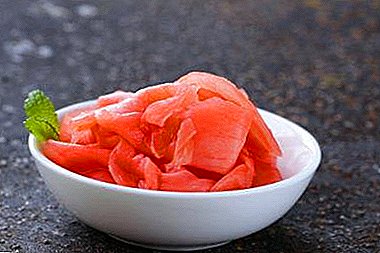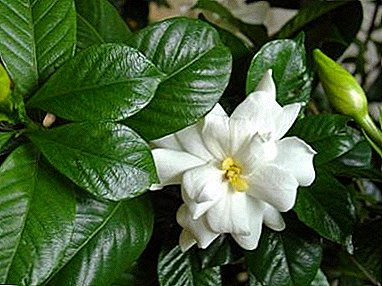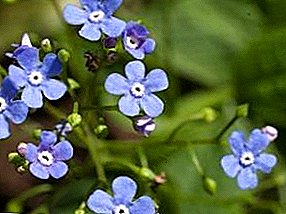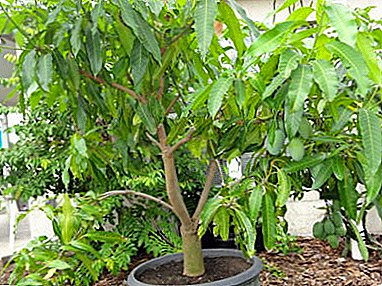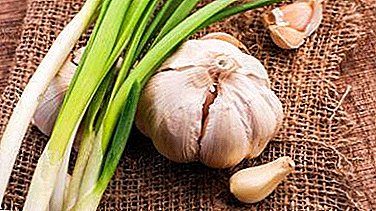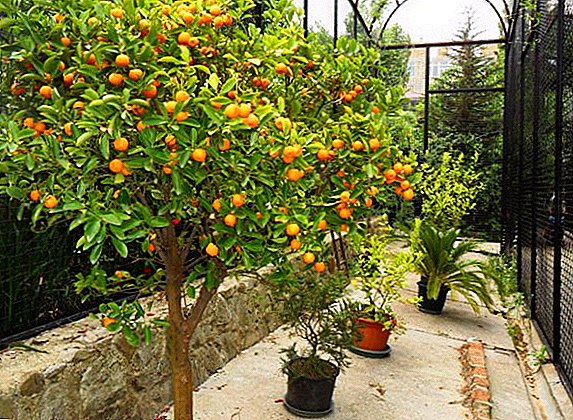 Tangerines for open ground are citrus fruits, which, compared to oranges, have much more variations in such aspects as the size and color of the fruit, the difficulty of peel separation, taste and aroma, the ripening season. Breeders have to fulfill any requirements of picky consumers of this fruit. They are interested in which varieties have a high sweetness and aroma, as well as tangerines with easily peelable and completely seedless.
Tangerines for open ground are citrus fruits, which, compared to oranges, have much more variations in such aspects as the size and color of the fruit, the difficulty of peel separation, taste and aroma, the ripening season. Breeders have to fulfill any requirements of picky consumers of this fruit. They are interested in which varieties have a high sweetness and aroma, as well as tangerines with easily peelable and completely seedless.
Did you know? At the same size, the sweet fruits of mandarins are slightly heavier than sour ones.Consider the achievements of breeding science in the creation of mandarin varieties for open ground.
Fairchild variety
This variety is a hybrid plant derived from Clementine and Orlando Tangelo. Breeding was done in 1964 by Dr. Joe Fourr in the USA. This variety is well suited for the desert regions of California and Arizona, where it began to be grown. The fruits ripen from November to January.
The Fairchild mandarin tree has numerous extended branches with dense foliage, almost without thorns. For better fruiting of fruit, additional artificial pollination is necessary. Fruits are medium sized, slightly flattened, have a medium-thin dark orange peel. Fruits of this variety are not very easy to clean, they contain a lot of seeds, but the taste is rather juicy, sweet and fragrant. The surface of the mandarin has a smooth texture. The weight of one fruit on average is about 100 g. The acidity of the variety is 0.7%, and juiciness is about 40%.
Variety Honey (previously had the name Murcott)
Murcott variety is a hybrid of orange and mandarin. Grown since 1916 in the United States. Named after Charles Murcott Smith. Widely grown in Florida and ripens in January - March. Trees are medium in size, grow vertically upward, but have curved branches, since the fruits are placed at their ends. Leaf size is small, lanceolate, pointed. The variety is very productive. Tangerine tree can die because of the abundance of fruits, which leads to its carbohydrate depletion. Fruits are medium in size, have a thin smooth yellow-orange peel, which is not very easily removed. The fruit is divided into 11-12 moderately stuck together lobes. The flesh has an orange color, tender, very juicy, with a few small seeds. Trees are prone to diseases of citrus scab and Alternaria fungus and are very sensitive from all varieties to cold. 
Sort Sunburst
This variety was bred in Florida in 1979. It was obtained by crossing varieties Robinson and Osceola. The harvest period is from December to February. Fruits have good taste, small size, beautiful dark orange color and smooth skin that does not exfoliate well. 
Important! The white mesh between the mandarin lobules is rich in glycosides, which strengthen the heart, so it should not be thrown away.
Sort Robinson
The variety was obtained in Florida in 1962 from the Clementine and Orlando Tangelo varieties. Fruits ripen from November to January. They are medium-small in size, dark orange in color, with a rounded or slightly narrowed base. The peel is removed poorly, so the pulp looks disheveled. The segments of the pulp are numerous (12-14 units), easily separable. The flesh is sweet, juicy, aromatic, with a moderate amount of orange seeds. The tree grows vertically upwards and has a thick crown that expands at the top. Leaves lanceolate, pointed, have notches on the tip.
Fallglo variety
A hybrid variety that consists of 5/8 mandarin, 1/4 of an orange and 1/8 of a grapefruit. It has large fruits measuring 7-8 cm in diameter. The shape of the fetus is flat, with a small navel. The peel surface is smooth, 0.3-0.5 cm thick, has a dark reddish-orange color. The fruit is easy to clean and has from 20 to 40 seeds. The tree grows vertically up without thorns and does not need pollination. The fruits ripen in September - November. The variety is resistant to citrus scab and fungal diseases, but is susceptible to tla. This variety has a lighter in color and smaller foliage in size and does not belong to cold-hardy.
Variety Dancy
The variety was planted in Florida in 1867, where, presumably, it came from Morocco. The fruits are pear-shaped, oblate, of medium size. The peel is smooth, glossy, dark orange-red. The flesh is juicy, orange in color and of excellent quality. The fruits ripen in November-December. Was the leading industrial brand in Florida. Its popularity has lost due to its sensitivity to various diseases. The variety was instrumental in breeding hybrids.
Clementine variety
The variety was created in 1902 by the French priest and breeder Clement Rodier. Belongs to a hybrid variety created from mandarin and orange of the blood orange from subspecies of oranges. The fruits have the shape of a tangerine, very sweet, orange. The size of the fruit is small, the skin is tight to the pulp. The ripening period is November - February.  There are such types of mandarins Clementine:
There are such types of mandarins Clementine:
- Corsican - has orange-red peel, pulp without seeds and is sold with two leaves near the fruit;
- Spanish - can have both small and large-sized fruits and contains from 2 to 10 seeds in each fruit;
- Montreal - a mandarin of a rare species, the harvest begins in mid-October, the fruit contains 10-12 seeds.
Sort Tangelo
The hybrid variety was obtained from mandarin and grapefruit in 1897 by Walter Tennyson Swingl USA. A large fruit with yellow-orange flesh that has a sour taste. The peel is easy to clean and has an orange color. Trees of this variety are quite large in size and frost.
Did you know? The flag of the city of Batumi in Georgia shows three mandarins. Notable Chinese officials in ancient times were called tangerines.
Minneola variety
The variety of tangerines Minneola is a variety of Tanzhelo. It was launched in 1931 in Florida. This is a hybrid variety derived from Dancy's mandarin and Duncan grapefruit. Mandarins are slightly flattened in shape, large in size, 8.25 cm wide and 7.5 cm high and red-orange in color. The skin is thin, strong. The flesh tastes sweet and sour, aromatic, consists of 10-12 cloves, which contain 7-12 small seeds. Variety refers to the late, but if the fruit is kept for a long time on the tree, then at the next harvest the fruit will have a light color. A valuable quality of this variety is a high content of folic acid: per 100 g of product - up to 80% of the daily allowance of a person. The Minneola variety is grown in the USA, Israel, Turkey, and China. 
Variety Tangerine
Mandarin Tangerine is a famous variety originally from China. Fruits differ excellent tastes, with a bitter aftertaste, bright orange color, with a reddish tinge. The rind of the fruit is smooth and thin. Have a stronger flavor than ordinary mandarins. The pulp has a sweet taste and does not contain seeds. In Europe, grown in Sicily. The main producer of Tangerine in the world is the USA. There are hybrid forms of Tangerine and other citrus fruits called Tanzhelo.
Sort Temple
This variety is often called the Royal Mandarin. Fruits of large sizes have a thick, strongly bumpy orange peel. Fruit pulp is very fragrant, juicy, sweet, with a lot of seeds. Harvest period is from January to March. 
Important! If the skin of a mandarin seems polished, then it was waxed. This is normal for better preservation of fruit during transport. These fruits must be washed.
Osceola variety
Osceola mandarins are medium-sized, oblate in shape, sometimes may have a crinkled skin. The skin is thin, moderately adjacent to the pulp, but easy to clean. Fruits have an orange-red color, smooth and shiny surface. The flesh is yellow-orange, juicy, rich and peculiar, with a small amount of seeds. The tree grows vertically upwards and has dense foliage, practically without thorns.
Summarizing the descriptions of the main varieties of mandarins, we can say that they have significant features and even superiority compared with oranges and grapefruits. First, it is the small size and flat shape of the fruit; secondly, the peel and lobules are separated much easier, and the middle remains empty; thirdly, tangerine trees are much more frost-resistant and differ by leaf petioles, small sizes of flowers, edging of leaf blades and a small number or lack of needles, and most importantly - an unforgettable taste and aroma of pulp.



